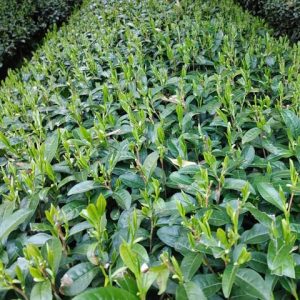
Komakage (駒影) can be translated as “horse shadow”.
There’s very few information about this cultivar online, and I haven’t tasted it yet.
However, there’s an interesting reason behind its name. That’s why I decided to write this post.
History of Komakage
Komakage is an unregistered tea cultivar developed in 1954 at the Kyoto prefecture tea research center.
It comes from tea seeds selected in Uji.
These seeds were from Manpuku temple (万福寺).
Close to that temple, there’s a monument named Koma no ashi kage en (駒蹄影園碑).
Here’s the location in Google maps.
The monument honors Myoue Shounin, who is considered to be the father of Uji tea.
Basically the monument says that at the beginning, people in Uji didn’t know the correct spacing to plant tea seeds.
So Myoue Shounin rode his horse through the fields, and told them to plant upon the hoof tracks.
Apparently the tea plants grew well, hence the monument.
The Komakage cultivar is named after this anecdote.
The “shadow” part of the name may also refer to the fact that this cultivar was initially meant for gyokuro production, although now it is used for sencha too.
Characteristics of Komakage
Young leaves of Komakage are small, elliptical in shape, and slightly thick, with good luster.
Mature leaves are also small, elliptical, with medium thickness, and a deep green color with few luster.
There are few creases in the leaves, and have a small serration.
This cultivar has a medium yield at harvest.
Komakage is very resistant to cold weather, has medium resistance to anthracnose, and is strong against the gray blight.
As a sencha, the leaves have a good shape and a vivid color.
It has a characteristic aroma and rich flavor.
